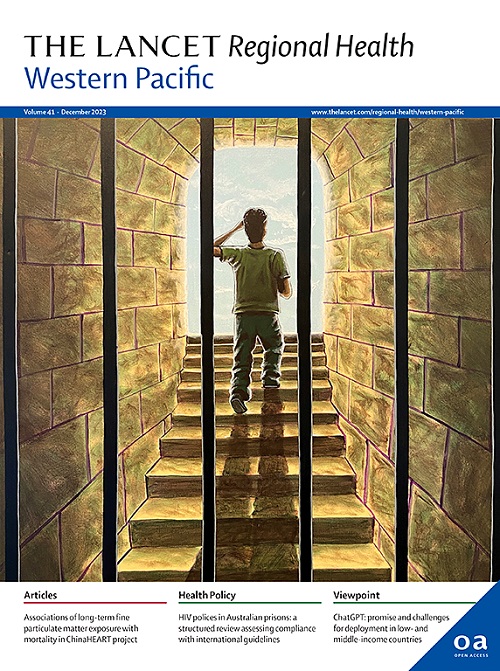Post-pandemic excess mortality of COVID-19 in Hong Kong: a retrospective study
IF 7.6
1区 医学
Q1 HEALTH CARE SCIENCES & SERVICES
引用次数: 0
Abstract
Background
As the COVID-19 pandemic shifted into the post-pandemic period in early 2023, following the COVID-19 normalization with relaxation of stringent control measures and high vaccination coverage in Hong Kong, its long-term impact on mortality remains challenging with necessary needs of data-driven insights. This study examined the pattern of post-pandemic excess mortality in Hong Kong.
Methods
We analyzed weekly inpatient death data from public hospitals from January 1, 2013, to June 1, 2024, using a mixed model with over-dispersed Poisson regression. Expected mortality was estimated as the difference between observed mortality and baseline derived from pre-pandemic data. Age-stratified analyses of overall and cause-specific mortality were conducted across the pre-Omicron pandemic, Omicron, and post-pandemic periods.
Findings
In the post-pandemic period, the excess mortality declined but remained six-fold higher (37.66 [95% CI: 32.72–42.60] per 100,000) than pre-Omicron level, maintaining significance after adjusting for age (32.79 [95% CI: 28.13–37.46] per 100,000). The older population experienced sustained excess mortality, with crude estimates of 100.51 and 586.74 per 100,000 among those aged 65–79 years and ≥80 years, respectively, primarily due to respiratory diseases. Younger population showed near-zero overall excess mortality, whereas increased excess mortality among them occurred in heart disease, cerebrovascular disease, and injuries.
Interpretation
Our findings highlight the lasting mortality impact of pandemic among vulnerable populations, specifically the older population, possibly due to the post-COVID conditions and circulating COVID-19, suggesting the need for targeted interventions for this group.
Funding
Health and Medical Research Fund.
香港COVID-19大流行后的超额死亡率:一项回顾性研究
随着香港放松严格的控制措施和高疫苗接种率,COVID-19大流行在2023年初进入大流行后时期,其对死亡率的长期影响仍然具有挑战性,需要数据驱动的洞察力。这项研究调查了香港大流行后死亡率过高的模式。方法采用过分散泊松回归混合模型,对2013年1月1日至2024年6月1日公立医院每周住院死亡数据进行分析。预期死亡率是根据观察到的死亡率与根据大流行前数据得出的基线之间的差异来估计的。在“欧米克隆”大流行前、“欧米克隆”大流行和大流行后时期,对总体死亡率和死因特异性死亡率进行了年龄分层分析。在大流行后时期,超额死亡率有所下降,但仍比欧米克隆前的水平高出6倍(37.66 [95% CI: 32.72-42.60] / 10万),在调整年龄后保持显著性(32.79 [95% CI: 28.13-37.46] / 10万)。老年人口的死亡率持续偏高,65-79岁和≥80岁人群的粗估死亡率分别为100.51 / 10万和586.74 / 10万,主要原因是呼吸道疾病。年轻人群的总体超额死亡率接近于零,而心脏病、脑血管疾病和损伤导致的超额死亡率增加。我们的研究结果强调了大流行对弱势人群,特别是老年人群的持续死亡率影响,这可能是由于COVID-19后的条件和COVID-19的传播,这表明需要对这一群体进行有针对性的干预。卫生及医学研究基金
本文章由计算机程序翻译,如有差异,请以英文原文为准。
求助全文
约1分钟内获得全文
求助全文
来源期刊

The Lancet Regional Health: Western Pacific
Medicine-Pediatrics, Perinatology and Child Health
CiteScore
8.80
自引率
2.80%
发文量
305
审稿时长
11 weeks
期刊介绍:
The Lancet Regional Health – Western Pacific, a gold open access journal, is an integral part of The Lancet's global initiative advocating for healthcare quality and access worldwide. It aims to advance clinical practice and health policy in the Western Pacific region, contributing to enhanced health outcomes. The journal publishes high-quality original research shedding light on clinical practice and health policy in the region. It also includes reviews, commentaries, and opinion pieces covering diverse regional health topics, such as infectious diseases, non-communicable diseases, child and adolescent health, maternal and reproductive health, aging health, mental health, the health workforce and systems, and health policy.
 求助内容:
求助内容: 应助结果提醒方式:
应助结果提醒方式:


